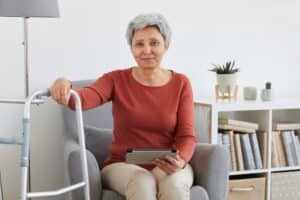
As the years go by, many seniors express a strong desire to continue living in their own homes independently, a phenomenon known as aging in place. This choice comes with various benefits, such as maintaining a sense of familiarity and autonomy. However, to ensure a safe and comfortable living environment for seniors, addressing potential fall risks and hazards within the home is crucial. This article will delve into the essential aspects of home safety for seniors aging in place, providing actionable insights and expert advice to promote their well-being.
Assessing Home Safety
The first step in creating a safe environment for seniors aging in place is to conduct a comprehensive home safety assessment. This assessment should involve identifying potential hazards and fall risks. Key areas to focus on include:
- Flooring: Ensure that flooring is slip-resistant and in good condition. Carpets and rugs should be secured to the floor to prevent tripping.
- Stairs: Install handrails on both sides of the staircase, and ensure steps are well-lit with non-glare lighting.
- Bathrooms: Add grab bars near the toilet and in the shower or bathtub. A non-slip bath mat is also essential.
- Kitchen: Keep commonly used items within easy reach to avoid the need for excessive bending or reaching.
- Lighting: Adequate lighting throughout the house is crucial. Consider motion-activated lights in hallways and bathrooms.
- Entrances: Ensure that halls are well-lit and have slip-resistant surfaces.
Bathroom Safety Modifications
Bathrooms can be particularly hazardous for seniors due to the presence of water and slippery surfaces. Here are some essential modifications to consider:
- Grab Bars: Install grab bars near the toilet, shower, and bathtub. These provide stability and support when standing, sitting, or transitioning.
- Shower Chairs: A shower chair or bench can make bathing safer and more comfortable for seniors with difficulty standing for extended periods.
- Non-Slip Mats: Place non-slip mats inside and outside the shower or bathtub to prevent falls.
- Raised Toilet Seats: Installing a raised toilet seat can make it easier for seniors to sit down and stand up.
- Handheld Showerheads: These allow for greater flexibility during bathing and can reduce the risk of slipping.
Bedroom and Living Area Modifications
Seniors spend a significant amount of time in their bedrooms and living areas. To make these spaces safer, consider the following adjustments:
- Bed Rails: Install bed rails to support when getting in and out of bed.
- Furniture Arrangement: Rearrange furniture to create clear pathways and reduce the risk of tripping.
- Chair Lifts: If mobility is severely limited, chair lifts can assist seniors in standing up from a sitting position.
- Adequate Lighting: Ensure that bedrooms and living areas are well-lit, and use nightlights in hallways and on the way to the bathroom.
Kitchen Safety Enhancements
The kitchen is a high-traffic area in most homes, and it’s essential to make it as safe and accessible as possible:
- Lowered Countertops: Consider lowering countertops to accommodate seniors who use wheelchairs or have mobility issues.
- Pull-Out Shelves: These shelves make it easier to access items in cabinets without reaching deep inside.
- Lever-Style Faucets: Lever-style faucets are more accessible to operate than traditional knobs.
- Anti-Scald Devices: Install anti-scald devices on faucets to prevent accidental burns from hot water.
Home Security and Communication
Ensuring that seniors can communicate in case of an emergency is crucial for their safety:
- Medical Alert Systems: Consider investing in a medical alert system that allows seniors to call for help in case of a fall or medical issue.
- Phone Accessibility: Ensure that phones are easily accessible from all rooms in the house.
- Emergency Contacts: Create a list of emergency contacts and place it in a visible location.
- Smoke and Carbon Monoxide Detectors: Regularly test and maintain smoke and carbon monoxide detectors to ensure they function correctly.
Eco-Friendly Home Safety Modifications
While making these essential home safety modifications for seniors aging in place, it’s also possible to implement them in an eco-friendly way. Here are some strategies:
- Energy-Efficient Lighting: Opt for energy-efficient LED bulbs and motion-activated lighting to reduce electricity consumption.
- Low-VOC Paints: If repainting walls or surfaces, choose low-VOC (volatile organic compound) paints to improve indoor air quality.
- Sustainable Flooring: Consider sustainable options like bamboo or cork when updating flooring.
- Water-Saving Fixtures: Install water-saving fixtures in bathrooms and kitchens to reduce water consumption.
- Recycled and Recyclable Materials: Use recycled or recyclable materials for construction or renovation work.
By incorporating eco-friendly practices into home safety modifications, you can create a living space that protects seniors and minimizes environmental impact.
Aging in place is a choice that allows seniors to maintain their independence and cherished routines. However, ensuring a safe living environment is paramount. By conducting a thorough home safety assessment and implementing the necessary modifications, you can significantly reduce the risk of falls and hazards for seniors. Moreover, by incorporating eco-friendly practices into these modifications, you contribute to a sustainable future while promoting the well-being and security of your loved ones. Remember, a safe home is a happy home, and every effort to make it so is well worth it.